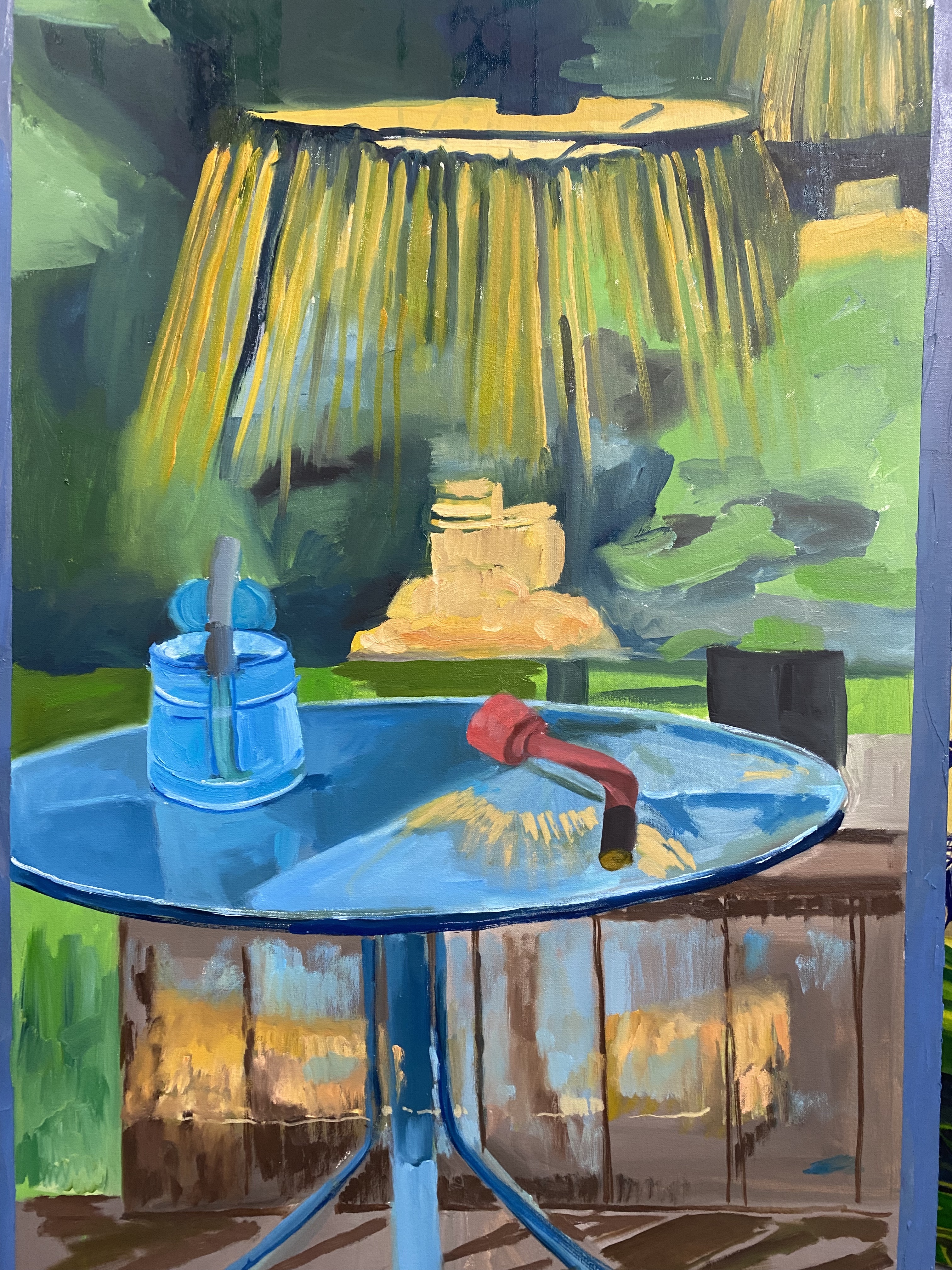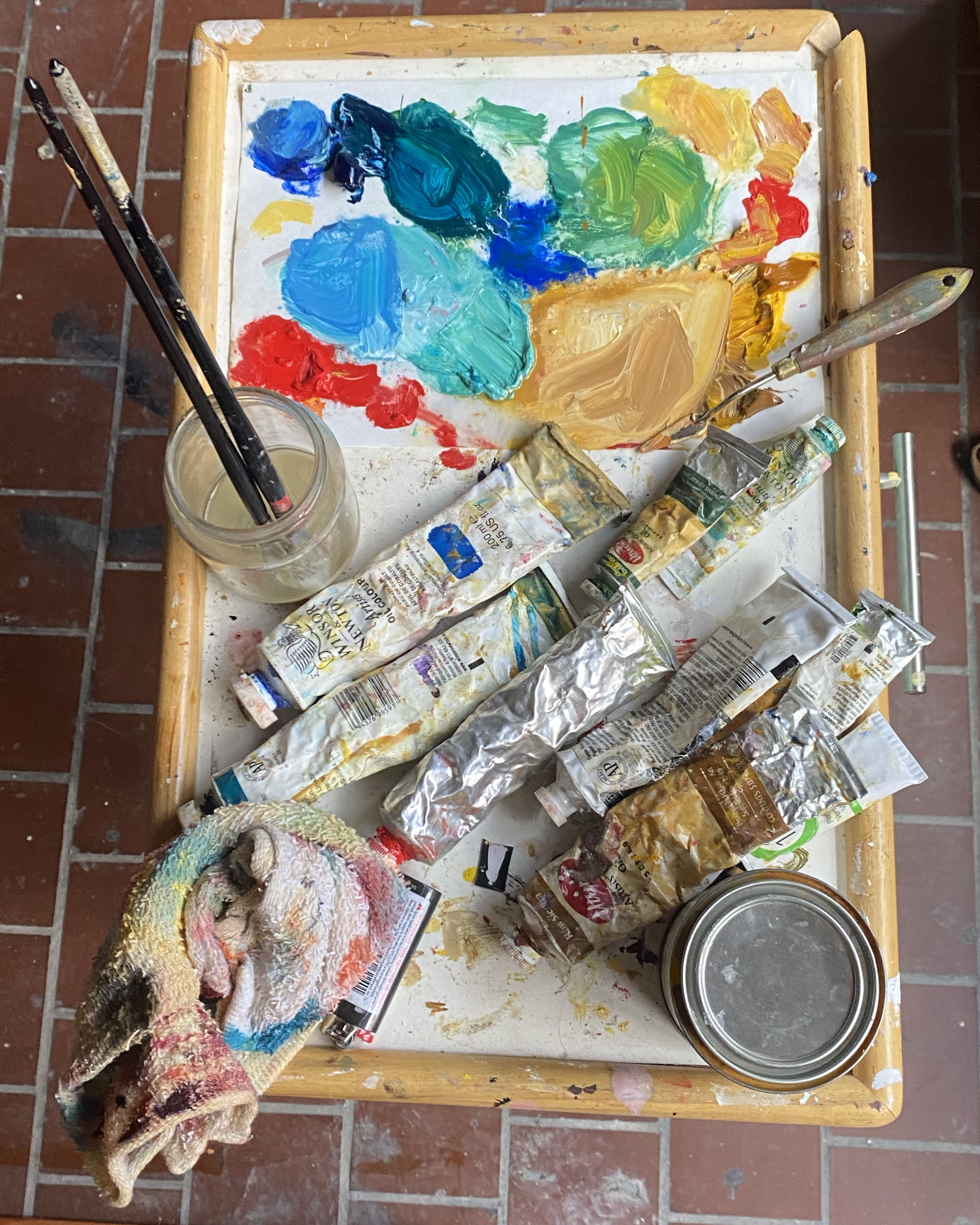In The Studio
AUGUST:
THINGS I’VE READ,
THINGS I’VE WRITTEN,
THINGS I’VE MADE,
THINGS I’VE SEEN
By NAAVA GUARACA
8.11.2021
“What I wanted most, apart from a different timeline, was a different kind of time frame, in which it might be possible both to feel and to think, to process the intense emotional impact of the news and to consider how to react, perhaps even to imagine other ways of being. The stopped time of a painting, say, or the drawn-out minutes and compressed years of a novel, in which it is possible to see patterns and consequences that are otherwise invisible.”
- Funny Weather, Olivia Laing
Things I’ve read lately:
From my journal lately:
-
Funny Weather is a survey of what we mean when we talk about “contemporary art.” Olivia Laing begins the book with mini artist biographies, some of them about people I love—David Wojnarowicz, David Hockney, Robert Rauschenberg. Her selections are, predictably, very white, very male, very classic. The whole book is. However, if you don’t know much about the influences behind a lot of contemporary practices, this survey of the scene in the 1960s-on acts as a great introduction.
The second part of the book focuses on Laing’s Frieze columns, compiling short essays she wrote over a period of time for the magazine. These tip more toward narrative essay with nonfiction influences. They’re mostly written in first person, and are each only somewhere between one and three pages. It’s cool to get a glimpse into Laing’s thought process; she gives us a chance to see how she relates life to art. In her last section she discusses books she’s read recently: The Argonauts by Maggie Nelson (one of my favorite books of all time), Normal People by Sally Rooney (another favorite of mine, though my love for it is often slightly controversial), I Love Dick by Chris Kraus (which I haven’t read but now probably will), to name a few.
Long story short: I wish Olivia Laing had written about less things in one book. I probably would’ve liked it more if she had offered some new perspective on the survey topics she covered.
-
I read Hour of the Star entirely on Phil’s Copy recommendation. I’d been meaning to read it for years and I’m so glad I finally did. It’s short - only around 80 pages - and translated from Portuguese. It follows a narrator telling the story of a young, poor girl named Macabéa who finds herself wholly unimportant. The story is beautifully written and felt so fresh compared to anything else I’ve read lately. Highly, highly recommend.
-
I’m currently around halfway through David Wojnarowicz’s Close to the Knives, which has been on my “to-read” list for what feels like forever. His show at the Whitney History Keeps Me Awake At Night, which showed while I was a freshman in college was huge for me (changed my life, etc). Most gay people consume a lot of media about the AIDs crisis accidentally. There’s a point at which most of us stumble upon that fun section of our history
-
Somehow, I’ve managed to stumble into a relationship with a person who knows me so well she came home the other day with a book called Slow Painting. Martin Hegbert wrote the intro essay, which says things like:
“One might view certain strands of painting in the twenty first century as released from the anxiety of engaging with modernity’s shadow, with progress or otherwise, and other as reconnecting with something painting did for centuries prior: build thoughtfully on the achievements of predecessors to wrangle ways of expressing what it means to be human, now.” It’s refreshing and wonderful and necessary to celebrate slowness.
From my journal lately:
-
My grandmother was a gardener. Only thing she loved more than my grandpa was her greenery. She started each day with a trip to the compost bin. Careful, we’d tell her, as she climbed down into the woods. She trusted herself around the trees arguably more than she did anywhere on solid ground. The earth ran through her. Spoke to all of us through her. Like she had special blood or something. She was always on a quest to identify trees before they could even notice her in their periphery. To me, who ran at the slightest buzzing of a bee, the way she trusted nature to never hurt her seemed like the furthest foreign thing. Sometimes it felt like she could plunge her arm into her rosebush and pull it out completely unscathed. Once a month her garden club would meet for a potluck. My grandparents would always make coleslaw, always in a big red bowl, with tin foil to protect it from the dangers of the world. We’d pile into the car during the warmer months and drive to someone’s house. I would wander the porch while grown ups stood drinking and eating, my sight line barely above anyone’s knees. My childhood was green, full of the consistent reminder that growth changes with the seasons. My grandmother was always proudest of that which she could keep green.
-
I think of things in terms of edges.
-
At the edge of the painting is a small bit that’s curved. And you have to think about the edges of a painting otherwise it won’t look right in your field of vision.
-
Text below reads: writing feels like such a painterly act lately. Like how right now I’m taking up more of the lines than I used to. I could do whatever here. I can tell whatever stories I want. As I start to build a “body of work” outside being in school, I’ve mostly started from strach, and I’ve been thinking of my life in designated “segments” lately -- like how there’s preschool/elementary school/middle/high/college and then there’s just life. I spend so much time looking at my parents’s lives in their 20s and here I am, seeing myself in them.

In the studio lately:
-
I recently added green to the painting of Arizona I’m working on. I’m trying to think of this second layer as an entirely separate layer with different properties than the first. There’s something about a first layer that feels so final, so sometimes I get nervous going into the second layer. It’s like here’s this huge thing I did—I put enough paint down to cover an entire surface and create a rendition of something tangible—and now let’s change everything that needs changing. It feels like a huge commitment when painting a large canvas, and comes down to trust more often than not. Trusting myself and feeling confident in my own decisions is something I’m famously not great at, so taking things slowly often helps.
-
Sometimes it happens when I’m painting where I get nervous going into a second layer because it’s like, okay, I did it once.. now I have to do it again but better? So much about the process of making a painting relies on confidence and trust. In both oneself as well as in the medium. In his essay that precedes Slow Painting, Martin Herbert describes the act as: “a locus of rich complication only accessible to those who either create slowly or work towards pictoral invention that requests persistent beholding, and that scatters gifts to the patient observer.” Painting is a very raw form of creating something out of nothing, and it’s a daunting task.
- I recently finished this small 12” x 12” piece called Night Cafe, which as I mentioned last time, was purchased by my wonderful friend Carla who lives across the street from me and also makes the most heavenly focaccia. If you’re in or near Brooklyn, her bread’s worth a travel.
- I started this painting, which currently has the appearance of being lush and oversaturated which is what I’m usually going for. The colors are bright and cohesive, and now that I’ve got a first layer down I’ll get to build a lot of depth on top of the basic sketch. There are so many small sections to this painting: the reflection of the lamp, the surface of the table, the reflection on the wood, the patterns on the deck, the trees behind everything. I tend towards working on a lot of things within a painting all at once, but I’m enjoying taking this one more slowly.

- I also started this other, larger painting that lives at my best friend’s studio. Barely one layer in it’s already started giving me a run for my money. I’m used to finishing first layers in one go, and the sheer surface quantity of 4 feet by 5 feet feels insane. These are the moments at which painting begs for confidence. I have to muster the willpower to throw myself entirely behind a painting that’s going to exist in such a huge way. It’s a work in progress already, and I need to remember that that can be just as exciting as scary. I’m not going to share a photo yet for fear of jinxing it (lol), but know it’s happening. Here’s a first layer palette:

-
Last week I spent a few hours at the studio with Joseph Olisaemeka Wilson, helping him stretch and unstretch some canvases. I love his work and always feel so inspired when I see him make anything. He works quickly, which is something I’m not prone to but always admire in others. I got to look through some of his reference material, some cool drawings he’s making. If you haven’t seen his work go to his website right now and scroll for a long time.
I’ve been listening to:
- Blue Weekend by Wolf Alice
- Sour by Olivia Rodrigo
- Home Video by Lucy Dacus
- David Bowie by David Bowie
- Open Wide by Rain Johannes
Outside the studio lately:
I went to see the Cezanne drawing show at MoMA for a second time and loved it even more than I did the first time. The sheer quantity of material included in the show is pretty overwhelming at first; rooms and rooms of walls full of drawings can be intimidating if you don’t know where to start. The installation of the show itself reminds me a lot of the layout the Met used for their Michelangelo show a few years ago. The rooms are dark, a lot of the frames are highly ornate. It’s clear from the get go that the show is itself a collection of years of carefully preserved work.
Cezanne’s dedication to his craft gets me every time. In my sketchbook I wrote: “he knew how to draw himself, the highest form of flattery.” I read this aloud to a friend and she said: “flattery?” and asked me what I meant by that. I explained that to know what oneself looks like and be able to translate that from something tangible to something two dimensional takes grit and courage. Self-imagery has such a different meaning now than it did in the nineteenth century, when Cezanne was looking in the mirror and drawing his beard. All he had to do was look, perceive, and translate. And who knows, maybe he too was crippled with exhausting self-doubt and an existential crisis every two weeks. It’s the common way of an artist. If anything, Cezanne provides an excellent reminder that the best option most of the time is just to shut up and draw.
- Cezanne, 1870
